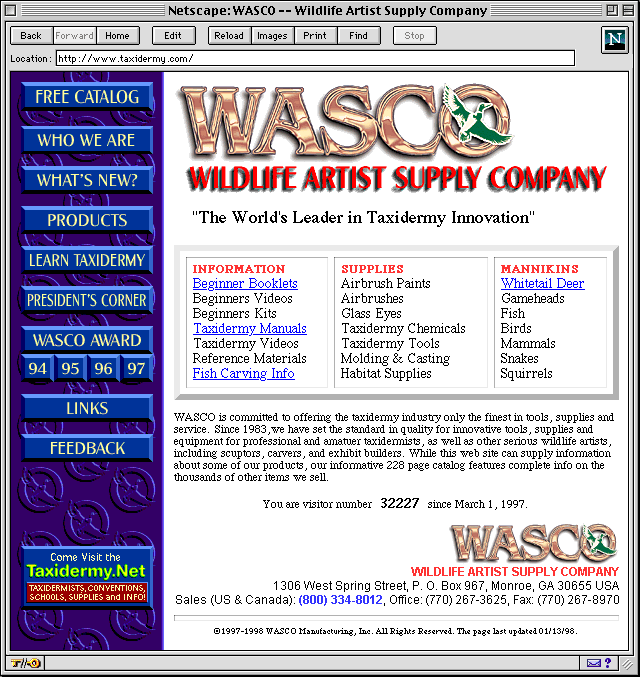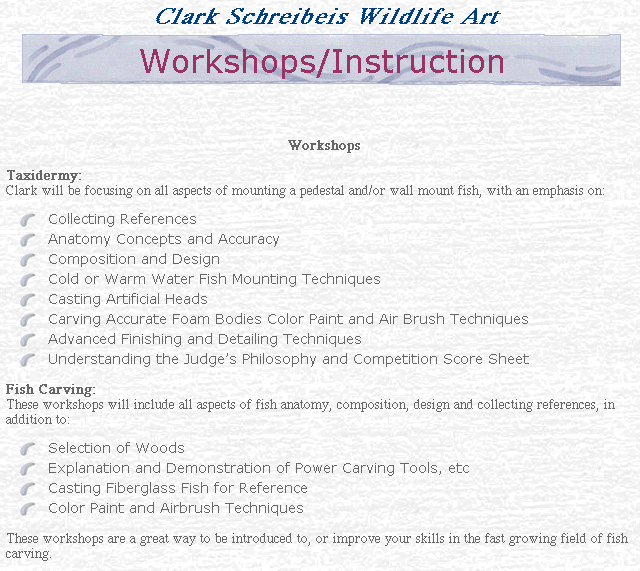 In the last decade of the last century, the internet transformed from total obscurity into the leading informational tool on the planet. In the 1990’s, as the world wide web was in its infancy, most web sites were based upon business cards or brochures; simply on-line flyers with basic information for prospective customers. Unlike the twenty-first century, where the internet beaome the leading communication tool, early web pages for taxidermy were quaint examples of one-way broadcasting in an emerging technology.
In the last decade of the last century, the internet transformed from total obscurity into the leading informational tool on the planet. In the 1990’s, as the world wide web was in its infancy, most web sites were based upon business cards or brochures; simply on-line flyers with basic information for prospective customers. Unlike the twenty-first century, where the internet beaome the leading communication tool, early web pages for taxidermy were quaint examples of one-way broadcasting in an emerging technology.
Does it seem like its only been 20 years since the internet took off? I remember getting the free AOL floppy discs in the mail and plugging them into my home computer, setting up the modem, connecting to the phone line, and warning all family members not to pick up the phone as I connected to this fledgling internet at ridiculously high per-minute rates. Once I was actually on-line, the first thing I did was to search (through the Alta Vista search engine, as there was no Google in existance yet) for anything to do with “taxidermy”. There were only three matches! Today, there are over 12 million results for the same search.
Over the next few months, I saw that number of three taxidermy matches increase into the hundreds. This is what gave me the idea to create the Taxidermy.Net website. I imagined a central website for the entire industry that included links to every taxidermy site on the internet, along with a central location for information on taxidermy conventions, associations, schools, workshops, publications, and studios. In 1996, we went online with the Taxidermy.Net, and it has followed the same philosophy ever since.
By two years later in 1998, the Taxidermy.Net website was huge success, having amassed over 100,000 visitors. With the addition of a new “Forums” section, visitors could actually participate in discussions, ask and answer questions, and be a part of an evolving community. These were the very first baby steps into a “social network” which everyone takes for granted today.
To promote the website, I prepared a print advertisement for the taxidermy trade publications. This ad was meant to show the variety of different taxidermy sites all organized within easy-to-use directories of the Taxidermy.Net. The ad ran in the fall of 1998 in Breakthrough and Taxidermy Today.

Recently, I discovered that I still had all of the original images that I used for that ad, which were made as screen grabs off the internet. As I looked through these images, I found these web pages fascinating examples of the earliest online presence of taxidermy. Most monitors were only 640 pixels wide, and many were limited to 256 web-safe colors. The type was still chunky-looking (no anti-aliasing to smooth things out as of yet), and the graphics had to be super-compressed in order to have file sizes small enough to be delivered over slow dial-up modems.
These lost early web examples make an interesting time-capsule as a snapshot of how taxidermy was presented on the internet sixteen years ago. They are presented at actual size for the screen resolutions at the time. I hope you enjoy looking at them.

The home page of the Taxidermy.Net featured Scott Lennard’s beautiful pedestal whitetail for over two years. Later, I began rotating new mount photos on the home page, featuring the best examples of artistic taxidermy. Mike Orthober’s brown trout is still in the main logo on our home page. Incidentally, Mike’s brown trout photo holds the record for the most widely transmitted taxidermy graphic, approaching a half-billion views.

If you clicked on “Taxidermists’ Web Pages” you would be taken to our taxidermy studio link directory. Early on, there were just a small number of studios with web sites but soon I had to sub-divide them by states to make the list more manageable. I was very proud of my clickable map, in which I spent hours hand-coding the pixel coordinates of each state in the map to point to a page location command. This map code is still in use 16 years later at http://www.taxidermy.net/taxidermists/tlinks.html.

If you clicked on any of the taxidermy studios in our directory, you would see a variety of early web design examples. Many, like this Mid Maine studio site, were simply an informational page set up similar to a business card. These type of simple pages were offered as a service through local web providers and business networks.

Many web sites featured nothing more than a business name and an email address.

Canned clip-art graphics were very popular. There were no digital cameras at the time and getting a print of a photo scanned was an expensive proposition. Scanners cost several thousand dollars.

Crazy 3-D type effects were popular, especially among newbies to desktop publishing who were presented with all manners of digital type manipulation.

Endless selections of type colors and patterns made for some interesting appearances.

Mike Boyce kept it simple and elegant, as he only used one home page to promote his artistry.

Bold repeating background patterns were common as well.

Wood patterns gave a rustic look to many outdoor-themed web pages.

With only 256 web-safe colors available, many type color choices seemed like a good idea at the time, but appear quite dated today.

While others kept color choices simple.

The internet was truly a word-wide phenomenon. Our horizons were opened up as European taxidermists could intermingle with North Americans at will. Young people today can’t imagine a time when international communication was so difficult and expensive that there was very little back-and-forth between continents. The web has made the world a much smaller place.

To reduce file size and loading times, photos would sometimes be so severely compressed that they would be riddled with JPG artifacts, which look like a checkerboard filter over the photo. This website by Pat Rummans helped him to land one of the biggest clients in the world, which he still works for to this day. We are sworn to secrecy on the identity of this client, but everyone in America has seen Pat’s work hundreds of times.

Realistic Taxidermy’s web site was one of the first I saw that used HTML frames in its design. I was so impressed that I added frames the the WASCO site after studying their code.

South Wind Wildlife Studio used a tiled marble texture background and a custom logo for a nice presentation.

Timberline kept it simple with a single photo and description.

Umbanhowar Taxidermy’s site was a good example of the graduated color background, very popular at the time.

Wildlife Artistry’s nice custom logo with a tiled background was typical of the website designs at that time.

WASCO donated the hosting and maintenance of the NTA website for free as a service to its members. As with many political issues, no good deed goes unpunished, and complaints from some members that a supply company was handling the NTA website brought an end to that era.

Jonas was an online pioneer, becoming the first taxidermy supply company to offer a complete on-line catalog, with all of its merchandise available to purchase right through your computer screen.

McKenzie had not yet set up any products on its web site in 1998. They promoted their huge and beautiful print catalog, which you could request by phone.

WASCO was setting up pages with products in 1998. When this screen shot was taken, we only had the products in blue as individual web pages. Online ordering was still a year off.

Aves had a very creative website, with a freestyle layout based upon custom artwork. The famous “Wisconsin’s Finest – Taxidermy and Cheese” sign made it to the pages of the humor magazine National Lampoon (another great institution made irrelevant by the internet).

John Bellucci’s website was ahead of its time. Like several sections of the Taxiderm.Net, it has not undergone a major design change in the past 16 years. His website looks virtually the same today.

Taxidermy schools found that the internet was a great place to get more students who were searching for instruction on line.

Explanations of curriculum and instructor biographies were par for the course.

Taxidermy schools throughout the country promoted their courses through web sites.

Even the great Clark Schreibeis had a website offering workshops in taxidermy, carving and art.

In the fall of 1998, the Taxidermy.Net Forums were opened. There was no off-the-shelf software to drive internet bulletin boards, so the Forum had to be hand-coded in HTML language by yours truly. Many months of trial and error finally resulted in the internet’s most popular taxidermy site, which is still active today, over two million posts later.